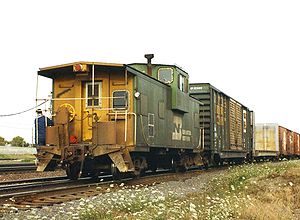
Crow's nest
Encyclopedia

This position ensured the best view of the approaching hazards, other ships or land. It was the best device for this purpose until the invention of radar
Radar
Radar is an object-detection system which uses radio waves to determine the range, altitude, direction, or speed of objects. It can be used to detect aircraft, ships, spacecraft, guided missiles, motor vehicles, weather formations, and terrain. The radar dish or antenna transmits pulses of radio...
.
In early ships it was simply a barrel
Barrel
A barrel or cask is a hollow cylindrical container, traditionally made of vertical wooden staves and bound by wooden or metal hoops. Traditionally, the barrel was a standard size of measure referring to a set capacity or weight of a given commodity. A small barrel is called a keg.For example, a...
or a basket
Basket
A basket is a container which is traditionally constructed from stiff fibres, which can be made from a range of materials, including wood splints, runners, and cane. While most baskets are made from plant materials, other materials such as horsehair, baleen, or metal wire can be used. Baskets are...
lashed to the tallest mast. Later it became a specially designed platform with protective railing.
It should not be confused with the top
Top (sailing ship)
On a traditional square rigged ship, the top is the platform at the upper end of each mast. This is not the masthead "crow's nest" of the popular imagination – above the mainmast is the main-topmast, main-topgallant-mast and main-royal-mast, so that the top is actually about 1/4 to 1/3 of the way...
, the platform in the upper part of each mast of a square-rigged sailing ship
Sailing ship
The term sailing ship is now used to refer to any large wind-powered vessel. In technical terms, a ship was a sailing vessel with a specific rig of at least three masts, square rigged on all of them, making the sailing adjective redundant. In popular usage "ship" became associated with all large...
.
Sometimes the term is used metaphorically in reference to topmost structures in buildings, tower
Tower
A tower is a tall structure, usually taller than it is wide, often by a significant margin. Towers are distinguished from masts by their lack of guy-wires....
s, etc.
Since the crow's nest is a point far away from the ship's centre of mass, any small movement of the ship is amplified and could lead to severe seasickness, even in accustomed sailors. Therefore, being sent to the crow's nest was also considered a punishment. Spanish "carajo" curse is derived from punitive usage of crow's nest named as such in Spanish.

Train
A train is a connected series of vehicles for rail transport that move along a track to transport cargo or passengers from one place to another place. The track usually consists of two rails, but might also be a monorail or maglev guideway.Propulsion for the train is provided by a separate...
s, the box-like structure above the caboose
Caboose
A caboose is a manned North American rail transport vehicle coupled at the end of a freight train. Although cabooses were once used on nearly every freight train, their use has declined and they are seldom seen on trains, except on locals and smaller railroads.-Function:The caboose provided the...
, the cupola
Cupola
In architecture, a cupola is a small, most-often dome-like, structure on top of a building. Often used to provide a lookout or to admit light and air, it usually crowns a larger roof or dome....
, was also called the crow's nest. It served for observation of the whole train when in motion.
In hunting
Hunting
Hunting is the practice of pursuing any living thing, usually wildlife, for food, recreation, or trade. In present-day use, the term refers to lawful hunting, as distinguished from poaching, which is the killing, trapping or capture of the hunted species contrary to applicable law...
use crow's nest is a blind -like structure where a hunter or a pair of hunters commit themselves to stalking game. Crow's nest is not a normal type, purchaseable blind, but it is an improvised position, built by using locally discovered natural flora
Flora
Flora is the plant life occurring in a particular region or time, generally the naturally occurring or indigenous—native plant life. The corresponding term for animals is fauna.-Etymology:...
(tree branches, moss, snow (during winter) or sand (during summer) etc.) Crows nest works in most environments and provides a good look out point (hence the name) when built in elevated position (hillside, or top of the hill).

